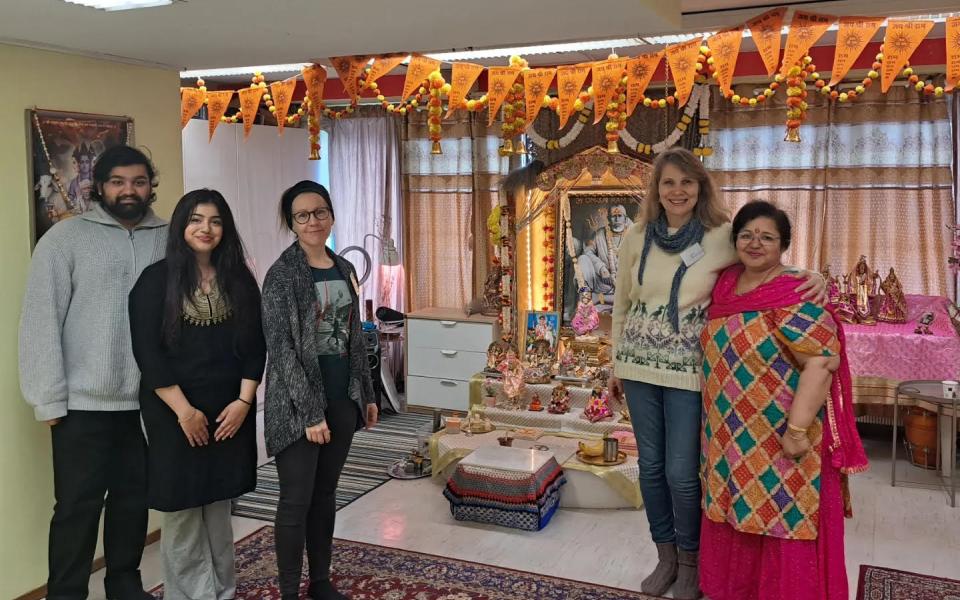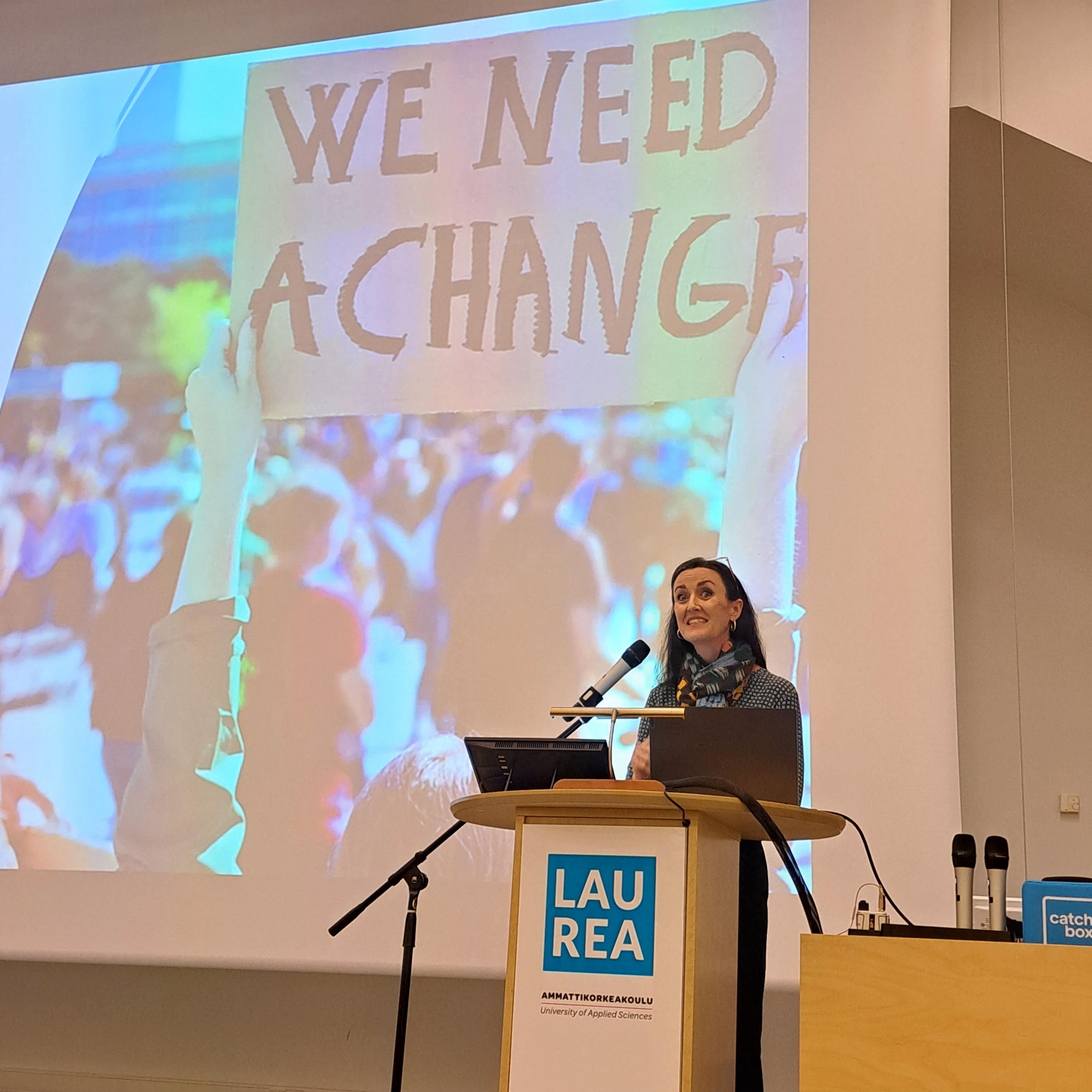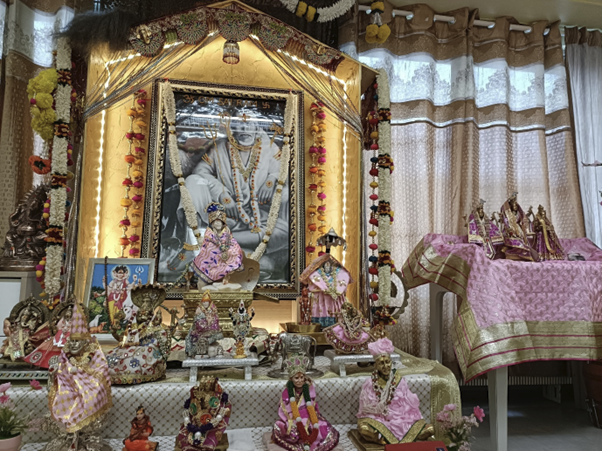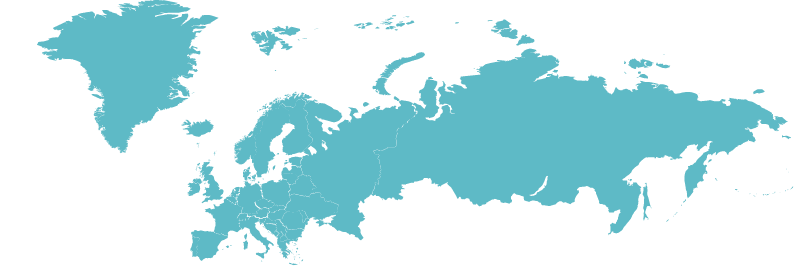Blog by Selja Koponen and Heidi Rautionmaa

Heidi Rautionmaa, a vocational and religious education teacher, journalist, and Lutheran pastor, has over two decades of experience organizing interfaith activities both in Finland and internationally. Heidi is one of the leaders of Faith without Borders Cooperation Circle in URI Multiregion.
She provides training on inter-worldview issues, primarily for teachers, religious communities, and youth, and is deeply engaged in global interfaith efforts. Heidi is a KAICIID Fellow, a board member of the European Network on Religion & Belief, and a committee member of Religions for Peace European Women of Faith Network. She has also served as an ambassador for the Parliament of the World's Religions and as a Global Council Trustee of the United Religions Initiative (URI).
Currently, she is involved in projects focusing on cultural, worldview, and language awareness in education, as well as peace and global citizenship education in collaboration with the University of Helsinki Centre for Educational Assessment.
It is our honor to share this insightful article with the URI network, reinforcing our shared commitment to education, dialogue, and interfaith cooperation as essential tools for building a more peaceful and understanding world.
Peace education and interfaith dialogue – building understanding together
The Finnish Social Pedagogical Society organized the annual social pedagogy conference on March 14th-15th in Espoo. The conference was co-organized with the Peace Education Institute and other cooperators, including three Universities of Applied Sciences (Laurea, Haaga-Helia, Metropolia). The authors (Selja Koponen and Heidi Rautionmaa) participated in the conference as workshop organizers, in-service teacher trainers as well as PhD researchers. In the following blog text, we reflect our insights from the conference; how peace education was portrayed and how does interfaith dialogue contribute to peace building.
Peace pedagogy, peace education or education for peace?
The theme of the conference was Peace Pedagogy in a World of Conflicts. Peace pedagogy was framed by the organizers as “education that seeks to foster the capacity for peaceful coexistence, the ability and willingness to resolve conflicts without violence, and a commitment to working together to build a better world”.
These definitions of peace pedagogy are consistent with the concept of peace education or education for peace that has traditionally been a part of global education even though the definitions of peace education are not always unambiguous (e.g., Basman-Mor, 2021; UNESCO, 2005).
Respect for life, human rights and democracy are indispensable to peace education, but other themes are also stressed, such as conflict resolution skills, well-being, compassion, trust, justice, and cooperation (Mishra et al., 2020; UNESCO, 2017).
Additionally, peace education can be described as the underlying impetus in teacher’s or educator’s work which means continuous professional growth and learning (Gursel-Bilging & Flinders, 2020). Peace education could therefore be described also as a holistic and contextual pedagogy, both a process and a goal (UNESCO, 2017; Dutta et al., 2016).
Fostering peace in an unjust world
The keynote speaker of the conference was Dr. Sara Clarke-Habibi, who specializes in peacebuilding through education. She began her insightful speech, based on her long experience as a practitioner, researcher, and curriculum developer, by addressing the current challenges educators have. There is an ongoing struggle with rising xenophobia and conservatism, for example, that pose a threat to human rights, democracy, and peace. Peace builders are truly needed in every section of society.

Dr. Clarke-Habibi emphasized that peace pedagogies are always plural; the context and the people you are working and interacting with have a significant role when choosing appropriate educational approaches and methods.
The objectives should not only be knowledge-related, for educators must combine, contextualize, and adapt pedagogies that are trauma-sensitive, culturally sensitive, multiperspective, self-reflexive and/or action-oriented, for instance. She stated that emotional and psychological sides of peace education should always be taken into consideration, as well as inner peace. For her, inner peace is a complex phenomenon, which has a temporal, relational, intra-, and inter-relational, as well as ethical dimension.
For us, a particularly poignant thought was the idea of inner peace as “a mature understanding”. According to Dr. Clarke-Habibi a mature understanding relates to universal ethics and is grounded on equality and equity. She argued that concepts such as positive and negative peace are important sociological concepts, but they are not enough. She highlighted the meaning of love and care, which create and maintain hope in an unjust world. These themes align with care ethics in which human relationality and co-dependency are acknowledged.
Interfaith dialogue as a peace pedagogy
The conference demonstrated to us, how education for peace is still overlooked in Finnish context. Even though the keynote speech as well as the panel discussion were focused on peace and peace pedagogies, the scientific presentations covered the theme of the conference only subtly.
One reason might be the historical baggage peace education has as a part of the process known as “Finlandization” where peace education was considered as a part of Soviet Union’s attempts to affect Finland’s policies (Savolainen, 2011). What also became evident to us during the conference was that the different worldviews, religious, secular, or political, were not discussed nor considered as a part of education for peace.
This caught us by surprise because a previous survey shows how teachers perceive religious diversity and different worldviews as challenging issues in teaching and education (KUPERA, 2021). In addition, the Finnish Ministry of Education and Culture published a study (OKM 2024:3) showing that subject teachers consider constructive interaction with other people to be a key objective of democracy education in lower secondary schools.
The study suggests that an open and conversational classroom atmosphere is conducive to democracy education, but that building openness is challenged by the diversity of opinions and divergent views of pupils from different backgrounds (e.g., cultural, ethnic, religious, etc.). We, however, consider everyday interfaith dialogue essential to education for peace.
With interfaith dialogue educators can address the challenging and difficult issues that religions and secular worldviews and their interactions may raise in mundane situations in classrooms. Constructive encounters that promote understanding and cooperation can play a pivotal role in preventing and resolving conflicts, achieving equality, and promoting democracy. The key issue is how to engage in constructive and sustainable interfaith and intercultural dialogue to promote well-being for all.
A hands-on workshop
As a part of the conference program, we organized an interfaith dialogue workshop in which participants got to know a Hindu temple in Leppävaara. This workshop was also a part of our upcoming in-service teacher training called Everyday Interfaith Dialogue in School, which starts on September 2024 and is funded by Finnish National Agency for Education. As in-service teacher trainers, we have already organized courses focusing on diversity skills and peace education in the University of Helsinki (Centre for Educational Assessment, CEA). With Heidi being an interfaith dialogue specialist with almost 30 years of experience, as well as a grass root peace activist, the natural next step was to organize a training focusing on interfaith dialogue as education for peace.
The workshop explored how to engage in dialogue with surrounding faith communities. This kind of cooperation will reduce prejudices and open new possibilities for peace education. At the temple which is dedicated to Shirdi Sai Baba (1838 – 1918), one of the best known and most respected gurus of Hinduism, we met law student Hitesh Bhaskar, upper secondary school student Purvi Bhaskhar, Saipriya Bhaskar and Marko Näätänen, a Hindu expert from Faith Without Borders. Hitesh, Purvi and Saipiriya told us about Hinduism, how it affects their daily lives and what kind of prejudices they have encountered in Finland. The dialogue between our hosts and participants was generative and we got to enjoy their delightful hospitality.

Even though religions and different worldviews play their part in conflicts, they can be a resource to reconciliation and peace (Neufeldt, 2011). Through mundane interfaith dialogue, respect and understanding can be fostered and cultivated. It is seen that people attending sustainable interfaith dialogue experience communicative, instrumental, relational, personal, and transformative learning. One field trip can serve as an initial step towards the process for deeper learning, but it is a crucial step that is sometimes the needed boost.
Concluding remarks
During her talk, Dr. Clarke-Habibi suggested that education for peace should be considered as an art. She continued by saying that, for example, co-creation, listening to others, and ceding control are some of the key components of peace pedagogies. To address and tackle the vicious global problems of today, we need the art of understanding. This entails curiosity and compassion toward the “other” and deeper understanding of humanity – and interfaith dialogue skills so that different world views, religious and secular, can be discussed constructively to cultivate peaceful coexistence and build a better world for all.
Selja Koponen & Heidi Rautionmaa
Selja Koponen is a doctoral researcher in educational sciences from the University of Helsinki. Her research focuses on democratic education and social sustainability. She is also a subject teacher in religious education.
Heidi Rautionmaa is a vocational teacher and a doctoral researcher from the University of Helsinki. Heidi provides training on inter-worldview issues mainly for teachers, people of religious communities and youth.
References:
Basman-Mor, Nurit (2021). Saving Peace Education: The Case of Israel. Higher Education Studies; Vol. 11, No. 1; 2021. p. 18-27.
Dutta, U. & Andzenge, A. & Walkling, K. (2016). The Everyday Peace Project: An Innovative Approach to Peace Pedagogy. Journal of Peace Education. 13. 1-26.
Gursel-Bilgin, G., & Flinders, D. (2020). Anatomy of a Peace Educator: Her Work and Workplace. Australian Journal of Teacher Education, 45(10).
KUPERA (2021). Kulttuuri-, katsomus- ja kielitietoinen perusopetus: KUPERA-tutkimus- ja arviointiraportti.
Mishra, L., Gupta, T. & Shree, A. (2020). Guiding Principles and Practices of Peace Education Followed in Secondary Schools of Mizoram. International Journal of Evaluation and Research in Education (IJERE) Vol. 9, No. 4, December 2020, pp. 1096-1101.
Neufeldt, R. C. (2011). Interfaith Dialogue: Assessing Theories of Change. Peace and Change, 36(3), 344–372.
OKM (2024:3). Yläkoulun opettajat ja demokratiakasvatus: Käsitykset, resurssit ja toteuttamismahdollisuudet.
Savolainen, K. (2011). Kasvatus maailmanrauhan välineenä: tapaustutkimus UNESCO:n 1974 hyväksymästä suosituksesta. Psykologia 46 1 (4): 30-34.
UNESCO (2005). Peace Education: Framework for Teacher Education.
UNESCO (2017). A Long Walk of Peace. Towards a Culture of Prevention.
